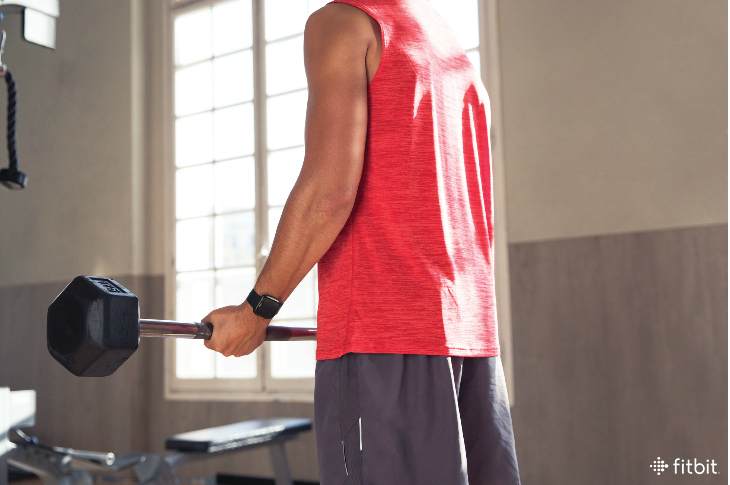
You know gradually adding weights is key to getting stronger, but how do you do that without putting your form—or body—at risk? Use a spotter.
“Experience plays a major role in who needs a spotter,” says Fitbit Local Ambassador and personal trainer Chris Perrin, but in general,“whenever weights are above your body and could potentially come crashing down on you, you may want to consider getting a spotter to watch your form and help you ditch any failed attempts safely.”
Before you head to the gym, check out the top five exercises that require spotter—plus how to return the favor if asked.
1. Seated Dumbbell Overhead Press
Muscle Targeted: Shoulders
How To Perform:
1. Grab a dumbbell in each hand, and sit on a flat bench. Rest both dumbbells on your thighs.
2. Bring the dumbbells to your sides and with your palms facing forward, lift the weights to shoulder height.
3. Exhale and push the dumbbells overhead.
4. Pause, then slowly lower back down as you inhale. That’s one rep.
How To Spot: “With a dumbbell overhead press, you want to stand behind the person lifting,” says Fitbit Local Ambassador and certified personal trainer Jeremy Walton. “Your hand placement should be at the triceps so that you’re assisting the lift at the point at which the person can fully extend their elbow. Never grab the wrists to spot.” As with other lifts, don’t touch the weights until the lifter needs assistance.
2. Dumbbell Chest Press
Muscle Targeted: Chest
How To Perform:
1. With your feet firmly planted on the floor, lie down on a flat bench with a dumbbell in each hand.
2. Pulling your shoulder blades back and down, press the dumbbells overhead so that your arms are directly over your shoulders and palms are facing forward.
3. Lower the dumbbells until your elbows are slightly below your shoulders. That’s one rep.
How To Spot: “On the dumbbell chest press, you want to kneel behind the head of the person lifting; your hands should be positioned under their triceps as they press the weight overhead,” says Walton. “When they get to the point where they’re struggling to complete the movement, press into the tricep to help them fully extend their elbow.”
3. Barbell Chest Press
Muscle Targeted: Chest
How To Perform:
1. Lie on a flat bench. With a medium-width grip (where your forearms and upper arms create a 90-degree angle mid movement), lift the bar off the rack.
2. Hold the bar overhead with arms locked.
3. Inhale and slowly lower the bar until it reaches the middle of your chest.
4. Pause, and exhale as you push the bar back overhead. That’s one rep.
How To Spot: “You want to spot a barbell chest press by standing behind the bench by the head of the person lifting,” says Perrin. “Position yourself standing over the bar with an under-over hand position. Don’t touch the bar; just allow your hands to hover. Follow the tempo of the person pressing. Once they reach a moment where they can’t finish the movement, grab the bar and assist the completion of the movement. Your goal isn’t to do all the work for them, but rather aid them in getting their muscles to safely adapt to the weight.”
4. Pull-ups
Muscle Targeted: Lats/ Middle Back
How To Perform:
1. Grab the pull-up bar with a medium-width grip. Your hands should be roughly shoulder-width apart.
2. With your arms extended, angle your torso about 30 degrees away from the bar to create a curvature in your lower back. Your chest should be elevated.
3. Contracting your lats—and squeezing your back muscles—exhale and lift your body, drawing your chest to the bar.
4. Hold the contracted position at the top for a second, then inhale and lower your torso back to the starting position. Finish with your arms fully extended. That’s one rep.
How To Spot: “With pull-ups, you want to be positioned behind the person,” says Perrin. “Their legs should be crossed as they rest the base of their shins in your hands. If they struggle to get their chin over the bar, allow them to push their legs into your hands to complete the range of motion. Make sure that you don’t push their legs; let their legs push into you.”
5. Barbell Back Squat
Muscle Targeted: Quadriceps
How To Perform:
1. Approach a bar on a squat rack. Facing the bar, place your hands shoulder-width apart. Dip under the bar, allowing it to rest on your traps.
2. Keeping your chest up, and with your feet in a hip-width stance with feet slightly turned out, squat down, driving your hips back and pushing your knees out.
3. Continue until your glutes are below parallel, then drive the weight upward as you stand back up. That’s one rep.
How To Spot: “When spotting a barbell back squat, position yourself behind the person squatting,” says Perrin. “As they squat, mirror their movement with your arms extended at their rib level. If they start to struggle and can’t get the weight up, hug them at the ribs and stand with them to fully extend. Then, walk with them to re-rack the weight.”
This information is for educational purposes only and is not intended as a substitute for medical diagnosis or treatment. You should not use this information to diagnose or treat a health problem or condition. Always check with your doctor before changing your diet, altering your sleep habits, taking supplements, or starting a new fitness routine.

For number 5.
Buy/build/use a squat rack. You don’t need anyone jammed against your butt while you attempt a PR max squat.
And that same rack, if in a home gym, or not in high demand, can sub for a spotter in just about any other barbell exercise, if the safety bars are correctly adjusted.